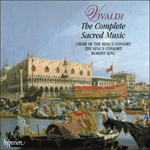
Welcome to Hyperion Records, a British classical label devoted to presenting high-quality recordings of music of all styles and from all periods from the twelfth century to the twenty-first.
Hyperion offers both CDs, and downloads in a number of formats. The site is also available in several languages.
Please use the dropdown buttons to set your preferred options, or use the checkbox to accept the defaults.

As usual, Arcadian and Christian forms of imagery mingle. The first aria speaks cheerfully in its first semistrophe of the beauty of a rose, while its second semistrophe (that is, the ‘B’ section of the da capo structure) moves to a contrasting, dark mood as it describes how, come the evening, the rose droops and loses its fragrance. This is the cue for the recitative to explain how all worldly glory is transitory, whereas the humble mother of Jesus is permanently glorious. It remains for the second aria, dance-like in its lilt, to sing Mary’s praise and prefigure some of the liturgical text of the Gloria to follow.
from notes by Michael Talbot © 2004
Comme toujours, les formes d’imagerie arcadienne et chrétienne s’entremêlent. Le premier aria est une évocation joyeuse, dans sa première semistrophe, de la beauté d’une rose, tandis que la seconde semistrophe (c’est à dire la section B de la structure da capo) évolue en revanche vers une atmosphère sombre, alors qu’elle décrit comment, le soir venu, la rose baisse la tête et perd son parfum. Telle est l’introduction d’un récitatif qui explique que toute gloire n’est qu’éphémère, alors que l’humble mère de Jésus reste, elle, glorieuse jusqu’à la fin des temps. Alors, le second aria, à la cadence presque dansante, chante la gloire de Marie et préfigure une partie du texte liturgique du Gloria suivant.
extrait des notes rédigées par Michael Talbot © 2004
Français: Marie Luccheta
Wie gewöhnlich treten hier arkadische und christliche Symbole nebeneinander auf. Die erste Arie handelt in der ersten Hälfte von der Schönheit einer Rose, in der zweiten Hälfte (dem „B“-Teil der Da capo-Struktur) jedoch ist die Stimmung eher düster und es wird beschrieben, wie die Rose am Abend ihren Kopf hängen lässt und ihren Duft verliert. Dies ist der Einsatz für das Rezitativ, in dem erklärt wird, dass alle weltliche Herrlichkeit vergänglich, die bescheidene Mutter Jesu’ hingegen von einer ewigen Herrlichkeit sei. In der zweiten Arie, die einen recht tänzerischen Rhythmus hat, wird Maria dann gepriesen. Außerdem werden hier bereits mehrere liturgische Texte des darauf folgenden Gloria angekündigt.
aus dem Begleittext von Michael Talbot © 2004
Deutsch: Viola Scheffel
 Vivaldi: The Complete Sacred Music Vivaldi: The Complete Sacred Music‘For King's sterling service to the Vivaldian cause, one of his most important recording and satisfying projects to date, I am thankful’ (Gramophone) ‘If you're waiting for the perfect collection of Vivaldi's sacred music, this is it. It was a happy day when this beautiful boxed set arrived in my m ...» More |

